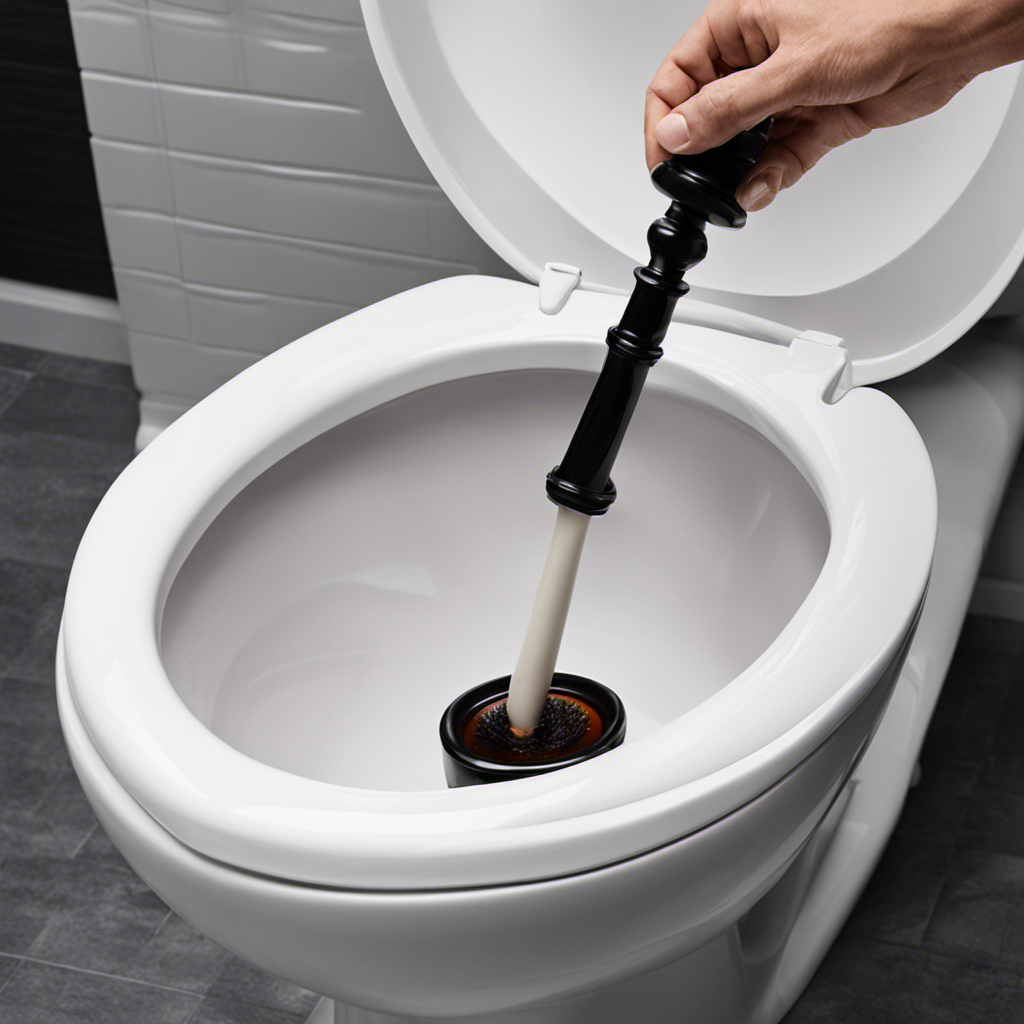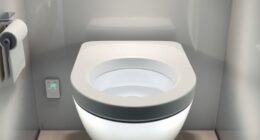I’m going to show you how to unclog your toilet in just a few simple steps.
It’s a common problem that can happen to anyone, and it can be quite frustrating. But don’t worry, with the right tools and a little know-how, you’ll have your toilet back up and running in no time.
So, let’s dive in and get rid of that pesky clog once and for all!
Key Takeaways
- Common causes of toilet clogs include improper flushing and accumulation of non-flushable items.
- Immediate action is necessary when signs of a clogged toilet, such as slow draining or water rising to the brim, are observed.
- Tools and materials needed for unclogging a toilet include a plunger, bucket, rubber gloves, wrench, and toilet auger.
- Alternative methods for unclogging a toilet include using a baking soda and vinegar mixture to create a foaming action and dislodge the blockage.
Common Causes of Toilet Clogs
You may be wondering, what are the most common causes of toilet clogs? Well, let me break it down for you.
Toilet clogs can occur due to a variety of reasons, but the most common ones are improper flushing and the accumulation of non-flushable items.
When it comes to toilet clog prevention, it is important to be mindful of what you flush down the toilet. Avoid flushing items such as wet wipes, paper towels, or feminine hygiene products, as they can easily cause clogs.
Additionally, keep an eye out for signs of a clogged toilet, such as slow draining or water rising to the brim. If you notice any of these signs, it’s important to take action immediately to prevent a complete blockage.
Tools and Materials Needed for Unclogging
To unclog the toilet, you will need a plunger, a bucket, and rubber gloves. Here’s a step-by-step guide to help you effectively unclog your toilet:
-
Start by putting on rubber gloves to protect your hands from any unpleasant mess.
-
Grab a plunger, ensuring that it has a good seal. Place it over the drain hole in the toilet bowl, making sure it covers the entire opening.
-
Push the plunger down firmly, and then pull up quickly. Repeat this motion several times, creating suction to dislodge the clog.
-
If the plunger doesn’t work, it’s time to use a drain snake. Insert the snake into the drain hole and rotate it clockwise to break up the clog.
By following these steps, you’ll be well on your way to unclogging your toilet and restoring normal function.
Now, let’s dive into the step-by-step guide to unclog a toilet.
Step-by-Step Guide to Unclog a Toilet
Start by putting on rubber gloves to protect your hands from any unpleasant mess while unclogging the toilet.
Unclogging a toilet can be a simple DIY task if you follow these steps.
First, assess the situation and determine the cause of the clog.
If it’s a minor blockage, try using a plunger to create suction and dislodge the obstruction. Make sure to cover the entire drain opening with the plunger and push and pull vigorously.
If the plunger doesn’t work, it’s time to try a toilet auger. Insert the auger into the drain and crank the handle to break up the clog. Be careful not to scratch the toilet bowl.
If all else fails, it may be necessary to remove the toilet and access the clog from the bottom.
Remember, these techniques are intended for minor clogs and DIY toilet repairs.
If the problem persists or worsens, it’s best to call a professional plumber.
Alternative Methods for Unclogging a Toilet
If the plunger and toilet auger don’t work, it might be worth considering using a mixture of baking soda and vinegar to help dislodge the blockage.
Here are four steps to using this natural remedy for unclogging toilets:
-
Gather the necessary materials: You will need 1 cup of baking soda, 2 cups of vinegar, and a pot of hot water.
-
Pour the baking soda into the toilet bowl: Make sure the baking soda covers the entire area of the blockage.
-
Pour the vinegar into the toilet bowl: The vinegar will react with the baking soda, creating a foaming action that helps break down the blockage.
-
Wait for the mixture to work: Let the mixture sit in the toilet bowl for about 30 minutes. Then, pour a pot of hot water into the bowl to flush away the blockage.
Using this DIY technique to unclog a toilet without using chemicals can be an effective and environmentally-friendly solution.
Preventing Future Toilet Clogs
You can reduce the likelihood of future clogs by being mindful of what you flush down the toilet. Regular maintenance is important to keep your toilet functioning properly and to prevent clogs.
Here are some eco-friendly solutions for preventing toilet clogs:
-
Use less toilet paper: Excessive toilet paper can lead to clogs. Use only what is necessary.
-
Avoid flushing non-flushable items: Items like wipes, cotton balls, and sanitary products should not be flushed down the toilet as they can cause blockages.
-
Install a toilet paper dispenser: This helps control the amount of toilet paper used and reduces the risk of clogs.
-
Consider using a bidet: Bidets use water to clean, reducing the need for excessive toilet paper.
Frequently Asked Questions
Can I Use a Plunger to Unclog the Toilet?
Yes, you can use a plunger to unclog the toilet. It’s a popular and effective method, but it’s important to use it correctly. Follow these steps to achieve the desired results.
What Should I Do if the Toilet Is Still Clogged After Using a Plunger?
If the toilet is still clogged after using a plunger, there are alternative methods you can try. If all else fails, calling a plumber might be necessary to resolve the issue.
Is It Safe to Use Chemical Drain Cleaners to Unclog the Toilet?
Using chemical drain cleaners to unclog the toilet may not be safe due to toxicity concerns. There are alternative methods available, such as using a toilet auger or a mixture of baking soda and vinegar.
Can I Use a Wire Hanger to Unclog the Toilet?
Yes, you can use a wire hanger to unclog the toilet. However, it has its pros and cons. It may help dislodge the blockage, but it can also damage the toilet and cause further issues.
How Long Does It Usually Take to Unclog a Toilet Using the Step-By-Step Guide?
Usually, it takes around 15-30 minutes to unclog a toilet using alternative methods. These methods include using a wire hanger, hot water and dish soap, or a toilet auger.
Conclusion
In conclusion, unclogging a toilet can be a messy and unpleasant task, but with the right tools and steps, it can be easily accomplished.
By following the step-by-step guide and using alternative methods if necessary, you can effectively clear the clog and restore your toilet’s functionality.
Just like a skilled plumber effortlessly maneuvers through pipes, you too can navigate through the challenges of a clogged toilet with confidence and ease.
So don’t let a clog stop you in your tracks, tackle it head-on and flush away the problem!









